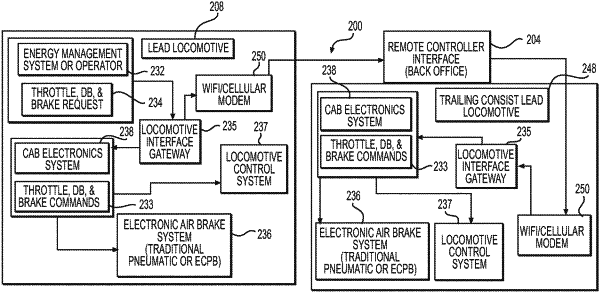| CPC B61L 3/006 (2013.01) [B61L 3/008 (2013.01); B61L 15/0072 (2013.01); B61L 15/0081 (2013.01); G06N 20/00 (2019.01)] | 20 Claims |

|
1. A train control system using an energy management machine learning modeling engine for maintaining coordination of controls or synchronization between a lead locomotive and one or more trailing locomotives in a train, the train control system comprising:
a centralized computer processing system located at one or more of the lead locomotive or a remote server in communication with the lead locomotive;
one or more distributed, edge-based computer processing systems located on-board one or more of the trailing locomotives of the train, wherein each of the distributed, edge-based computer processing systems is communicatively connected to the centralized computer processing system;
a data acquisition hub communicatively connected to one or more of databases and a plurality of sensors associated with the lead locomotive, the one or more trailing locomotives, or other components of the train and configured to acquire real-time and historical configuration, structural, and operational data in association with inputs derived from real time and historical contextual data relating to a plurality of trains operating under a variety of different conditions for use as training data;
the energy management machine learning modeling engine being associated with one or more of the centralized computer processing system or distributed, edge-based computer processing systems and being configured to create a centralized model of one or more actual train control systems in operation on-board the lead locomotive based at least in part on data received from the data acquisition hub, wherein the energy management machine learning modeling engine is utilized in a process of generating a first set of output control commands for a first train control scenario to be implemented by an energy management system associated with the lead locomotive;
the energy management machine learning modeling engine being further configured to create one or more edge-based models of one or more actual train control systems in operation on-board the one or more trailing locomotives of the train based at least in part on data received from the data acquisition hub, wherein a first one of the edge-based models is utilized in a process of generating a second set of output control commands for a second train control scenario to be implemented by an energy management system associated with at least one of the one or more trailing locomotives;
the energy management machine learning modeling engine being still further configured to:
receive the training data from the data acquisition hub;
receive the centralized model from the energy management machine learning modeling engine;
receive the first edge-based model from the energy management machine learning modeling engine;
compare the first set of output control commands for the first train control scenario and the second set of output control commands for the second train control scenario; and
train a learning system using the training data to enable the energy management machine learning modeling engine to safely mitigate any divergence discovered between the first and second sets of output control commands using a learning function including at least one learning parameter, wherein training the learning system includes:
providing the training data as an input to the learning function, the learning function being configured to use the at least one learning parameter to generate an output based on the input;
causing the learning function to generate the output based on the input;
comparing the output to one or more of the first and second sets of output control commands to determine a difference between the output and the one or more of the first and second sets of output control commands; and
modifying the at least one learning parameter and the output of the learning function to decrease the difference responsive to the difference being greater than a threshold difference and based at least in part on actual real time and historical information on in-train forces and train operational characteristics acquired from a plurality of trains operating under a variety of different conditions; and
at least one of the energy management systems associated with the lead locomotive and the one or more trailing locomotives of the train being configured to adjust one or more of throttle requests, dynamic braking requests, and pneumatic braking requests for at least one of the lead or trailing locomotives of the train based at least in part on the modified output of the learning function.
|